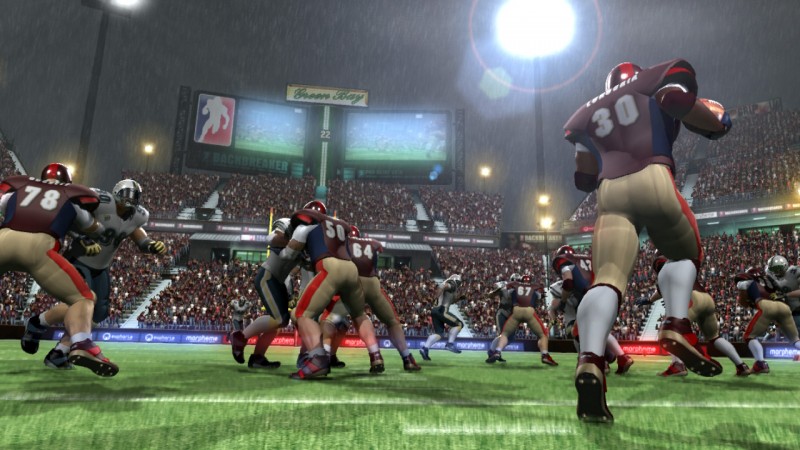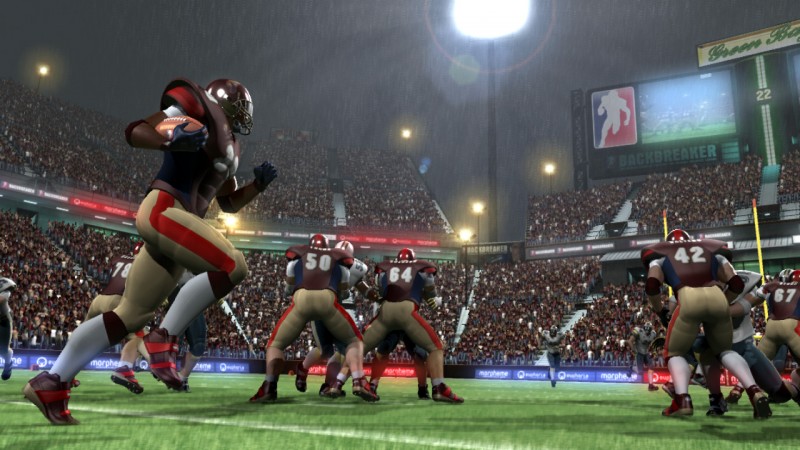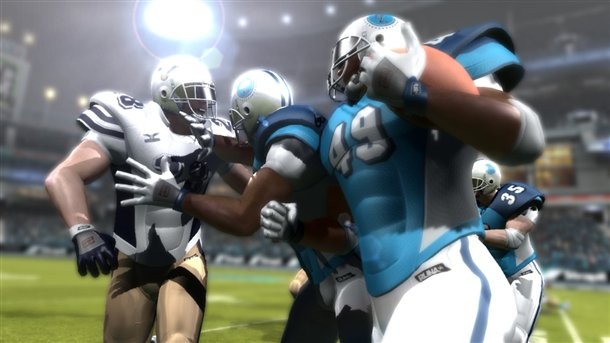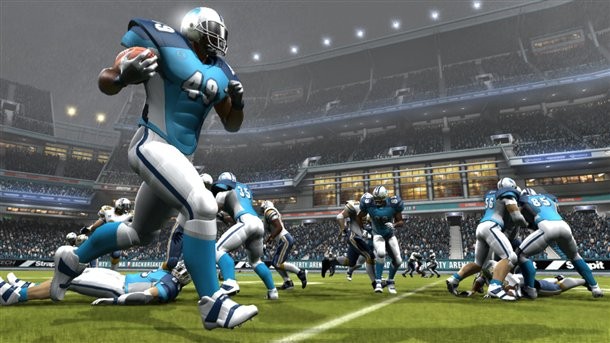Please support Game Informer. Print magazine subscriptions are less than $2 per issue
Backbreaker
With All-Pro Football and Blitz hanging up their cleats, EA is the undisputed king of football games. That isn’t stopping Natural Motion from going for it on fourth down with Backbreaker. Armed with the Euphoria engine that has powered the impressive animations for games like Grand Theft Auto IV and The Force Unleashed, Backbreaker aims to take down the NCAA and Madden publisher with its gritty, up close and personal brand of football. To get a better sense of what this game’s about, 505 Games supplied us with a preview build.
Building A Franchise
Life without the NFL and NFLPA is rough. Any football fan would prefer taking snaps with Drew Brees and the New Orleans Saints than an imaginary quarterback from an imaginary team. All-Pro Football made due by dishing out large sums of cash to pay for the likenesses of legendary players like John Elway and Barry Sanders. As an upstart developer funded by a less established publisher, Natural Motion didn’t have the resources to go this route, instead filling the game with a bunch of generic teams. To keep the hardcore NFL fans interested in the game, however, the devs included tools to let players customize up to 32 teams.
These customization tools give you free reign to name your team, create a logo with a Photoshop-like editor, fine-tune your jersey motif, choose a home stadium, re-name players, alter your team strengths, and change the number of “gold players” your team has on both sides of the ball. To avoid ugly lawsuits with EA and the NFL, however, you cannot name your upstart franchise the exact names of NFL teams and play online with them. Anything goes in offline play, but if you want to take the Minnesota Vikings onto the field against friends online, you’ll have to be creative. One workaround I found was to use the abbreviated city or state name. Typing the name San Francisco 49ers resulted in the pop-up box telling me that the name couldn’t be used online, but when I typed SF 49ers I received no such warning.
The same applies to player names. I tried names from every era of football – Fran Tarkenton, Tommy Kramer, Tarvaris Jackson – and I received the warning about not being able to take these names online each time. Even little known quarterback Steve Dils didn’t work, which leads me to believe that Natural Motion has a database featuring the names of every player who ever donned a helmet in the NFL. To get around this, NFL fans could intentionally misspell names or just use the abbreviation technique. Having players named A. Peterson and S. Rice may not be ideal, but it’s an acceptable workaround for dedicated fans. Unfortunately, if you want to create an entire 32-team league with NFL clones, you can’t rely on some hardcore fan in another state to do the dirty work for you. Backbreaker does not feature a tool to upload and share rosters or teams with other players.
Long-time Madden players may be equally irked by the lack of player customization. You can edit the name and number of each player, but have no control over their skill ratings, size, or weight. The only way to get better players on your roster is to move the slider that controls how many gold tier players are on your roster. The skill ratings feel rather empty considering the depths to which Madden credits attributes. Each player, no matter the position, is rated in four areas – focus, agility, speed, and strength. While these ratings may be fine for creating basic skill sets, there is no way to deduce what ratings affect abilities like quarterback accuracy, zone coverage, man-to-man coverage, etc.
Not allowing gamers to adjust the size and weight of players is also frustrating considering the physics engine driving Backbreaker. With the Euphoria technology simulating the physical prowess of a player based on his muscle mass and motor skills, the game could do a great job accentuating the immovable nature of gargantuan nose tackles like Pat Williams or the strength and height advantages a stud receiver like Larry Fitzgerald has going up against a 5’9 corner. The version of the game we played did have varying player skill implemented yet, so we won’t know if this will be the case until we play the final game.
Taking The Gridiron
Once I built my faux Vikings team and tweaked all the player names, I gave them a test drive in an exhibition match. For exhibition games you can choose from the 13 stadiums (three of which are locked upon startup) and alter whether the game takes place during the day or night. The only weather customization available was to choose whether or not you want rain. The game offers three gameplay modes – arcade, pro, or custom – but in our build the only mode properly balanced was arcade so we didn’t explore the other options. Independent of the game mode, you can also select easy, medium, or hard difficulty. Perhaps a nod to the developer’s British roots and passion for footy, you can also select the form of your team on a sliding scale that goes from very poor to very good – a feature is commonly seen in soccer games.
As Natural Motion describes it, the Arcade mode serves as the training wheel experience for Backbreaker. Ball carriers are highlighted on the field so players have an idea where the action is, the opposing team’s offensive plays appear on the field to give you a clue of where to focus your attention on defense, and your playcalling options are limited to only a handful of plays.
When the teams stepped on the field, differences between Backbreaker and Madden were everywhere. All of the players have LaDainian Tomlinson-like visors, and the painted-on jerseys look plastic and have no cloth movement. The huge shoulder pads and the strange, Batman-like abdomen plate gives the players a robotic look. The third-person camera angle is much tighter than in Madden, centering right behind the player you control.
Fielding the kickoff, I get my first taste of Backbreaker’s rushing system. Your momentum is controlled by how far forward you push the left analog stick. Face buttons are worthless when running the ball, as all your moves are tied to the right analog stick. Flicking the stick right or left results in a juke, and rotating them in semi-circles allows you to spin past defenders. Holding down the right stick activates the Aggressive rushing mode, which gives the player a slight boost in speed and allows you to stiff arm defenders by moving the right stick left or right. In this mode, you can also shoulder barge by pressing the right analog stick forward, or protect the ball from fumbles by pressing it downward.
Like All-Pro Football, Backbreaker lacks split-second responsiveness, so to properly juke past defenders you must activate the move well before you’re in the position to perform it. The tackling animations are easily the most impressive feature in Backbeaker; tackles can be made from all sorts of angles, and each one results in a different animation. Gang tackles happen naturally, and when a ball carrier gets hit at an awkward angle, it legitimately looks like an injury could have happened. The exhibition mode did not feature any injuries, but if Natural Motion is smart it will take advantage of the realism their animations impart and make them an important part of the season modes.
With Arcade mode’s dumbed-down playbook, players only have the option to select from four passing plays, four rushing plays, and four “Ask Coach” plays. The Pro mode features a much deeper playbook that breaks the plays up by formation as well as by play type.

Dropping Back To Pass
With the camera focused tightly behind the quarterback, it’s not easy to get a good look at the defense, but holding the left bumper pulls the camera away to the traditional birds-eye view found in Madden. Here you can review the receiver routes, change the primary receiver, and call one of the four programmable audibles with the d-pad. I couldn’t find any options for calling receiver hot routes or shifting blocking alignments.
After dropping back to pass, pushing forward on the right analog stick executes a bullet pass. You can also flick it back and forward to get some air under a bomb. To pump fake, simply flick the right analog stick downward. This analog-based approach is very easy to use, but runs into some difficulties when cycling through receivers.
Flicking left or right on the right analog stick changes the primary receiver between the players running routes. As with the juke moves, there seems to be a slight delay between flicking the analog stick and actually switching receivers. The system also had trouble rotating between options when the receivers were closely bunched together. This could be a major issue when facing a heavy blitz.
Holding the left trigger while dropping back to pass activates focus mode, which zooms in on the primary receiver and gives your quarterback an accuracy boost. You can throw the ball without using focus, but I found the accuracy was severely compromised; balls flew all over the place with no rhyme or reason as to why they would be so unruly.
Some of the passing animations look like a gym teacher did the motion capture instead of a pro quarterback. The dropback looks normal, but the quarterback doesn’t always shift his weight from back to front when heaving a long pass. This makes him look like a stationary robot with an amazingly strong arm. When heaving up a pass on the run, the throwing motions can look downright silly. The worst animation I saw was a limp-armed jump pass in the face of a heavy rush.
Pass protection worked well for the most part, with blockers naturally forming a pocket, double-teaming bigger defensive linemen, and shifting between defenders when necessary. Every once and a while, however, a blocker tripped the quarterback by running into him.
Once a pass is completed, the camera abruptly shifts to the receiver. This can be a disorienting experience when in traffic, and given the game’s inability to account for split-second button presses, it’s hard to make a quick move immediately after making the catch. How the receivers react to a pass seems to be intrinsically tied to whether or not you used the focus button to throw the ball. When I used the focus, the quarterback tended to throw the ball in a location that made it easy for the receiver to aggressively make the catch. When I didn’t use the focus throw, oftentimes the receivers would just stand there and not challenge for the ball if a defensive back was nearby. This was most evident in curl and comeback routes. The receivers also demonstrated a lack of awareness when negotiating the sidelines, and one ball ghosted right through the receiver and into the defenders hands – both problems that have plagued Madden for years.
The defensive zone coverages tend to sag, so your best bet for large gains is to scramble on a play that sends everybody upfield with go routes. With half the defenders playing 30 yards downfield, once you get past the line of scrimmage nothing is stopping you from making huge gains. This is compounded by the general lack of awareness in the defensive backs, who frequently stayed in coverage instead of pursuing a quarterback scrambling up the field.
Toting The Rock
Establishing the run is a key component to creating an effective offensive attack. Making defenders commit more men to stopping the run opens the door to single coverage on the outside and quick-strike scores. I live and die by this principle when playing football simulations, but I couldn’t for the life of me establish a decent rushing attack in Backbreaker.
Running the ball is plagued by multiple problems. The rigid running style of the backs works to their detriment the most. It’s tough to negotiate tight spaces because the backs run so upright, and the defense collapses run blocking very quickly. The running backs’ lack of wiggle makes it extremely tough to slide through tight holes, and I often found myself the victim of shoestring tackles from interior defenders who simply reached around their blockers.
Taking the rock outside on sweeps is hindered by an overly sensitive camera adjustment that swings too wide toward the sidelines. You can’t see the pursuit coming from the interior, which is where a running back’s eyes are normally focused on these plays. When running sweeps and powers I also felt like my running back was locked into a trajectory toward the sideline, and it was hard to negotiate him accurately toward the outside shoulder of the sealing blocker. Cutting back is also an exercise in frustration given the limited animation set that seemingly lacks the agile movements skill players at the running back position possess.
We Must Protect This House!
The starkest contrast between Backbreaker and Madden is in the game’s defensive camera. Rather than keep the same perspective for both offense and defense, the camera shifts behind the defenders. Placing you right in the thick of things gives playing defense a renewed sense of excitement that Madden currently lacks. Whereas the limited agile movements hinder the offensive side of the ball, they make guiding a defender a more controlled experience. The defensive players shift fluidly between strafing, backpedaling, and charging ahead.
Given the quickness with which an offensive player can change direction in Madden, my defensive strategy is frequently to get close and attempt a diving tackle. In Backbreaker, I felt much more in control of my player and less worried about a split-second move leaving me in the dust. Maybe it was just the difficulty setting, but in Backbreaker it seemed easier to keep up with the kinetic action, which made the process of hunting down and burying ball carriers in the turf a lot of fun. The diverse set of tackling animations also doesn’t hurt.
The only drawbacks to playing defense in Backbreaker are the inability to shift your defensive line or alter secondary coverages before the snap (maybe that will be in the pro mode) and the abrupt shift in camera perspective when you switch players during the action. To account for the disorienting shift, Natural Motion doesn’t place you in control of the closest defender to the ball, instead selecting a more removed player to give you a chance to gain your bearings. Even with this system in place, I found myself playing defense more like you would in a Be A Pro mode, never shifting to another position once the ball was snapped.
Arcade mode isn’t likely the best place to showcase the AI in Backbreaker, but it was laughably bad. I saw several instances where the quarterback tripped on an offensive lineman before handing the ball off. I also witnessed more than one fumble where the quarterback pitched the ball into the side of the fullback when it was intended for the tailback, resulting in a frantic scramble to recover the ball. The AI hardly fared better in the passing game, with most plays ending in a sack or an incompletion after the quarterback scrambled around indecisively. My opponents’ highest completion percentage in all the games I played was around 30 percent.
The playcalling also left a lot to be desired. The AI was smart enough to call timeouts when the clock is running out at the end of the half or the end of the game, but instead of throwing the ball to get one last score, most of the time the AI just ran the ball. Natural Motion said much of this is still being tuned, so this will likely be addressed in some way in the final version of the game.
Sunday In The Stands
Backbreaker’s procedural tackling animations may be innovative, but it has a long way to go in the presentation department. With no play-by-play announcing, the field feels pretty barren. Player chatter is nonexistent, and the crowd basically sounds like a blanket of white noise, hardly reacting to big plays. Natural Motion says it’s still working on fine-tuning the crowd noise to make the stands come alive during key moments, and the music hasn’t been integrated into the on-field experience yet, which should go a long way toward livening up the field.
Like the first Madden on next-gen consoles, Backbreaker’s presentation is leagues behind contemporary television broadcasts. I don’t recall seeing any statistical overlays breaking down the action outside of the obligatory halftime summary and frequent stat updates on the score bar that runs along the bottom of the screen, The “cutscenes” are clichéd, stagnant shots of the scoreboard indicating first downs, sacks, etc. You cannot check game stats in the pause screen.
The instant replay option could also use some work. In its current state, you can rewatch any play, but the camera angles are not adjustable, meaning if something happens away from your defender you can’t get a better look at it. The game also doesn’t seem to have a challenge system for correcting poor refereeing.
Speaking of refereeing, this aspect of the game sorely needs some tweaking. Several blatant pass interferences went uncalled, including one play were the defender knocked down the receiver before jumping up to make an interception. My quarterback also received a few false start penalties for gesturing toward the defense.

Breaking Down The Modes
To preserve the behind-the-back defensive camera angle from the single-player game, Backbreaker handles multiplayer via splitscreen. Given the up-close camera angles the game employs, the action can look very cramped on one screen. If you want to get the full Backbreaker experience with a friend, competing online is the way to go.
The majority of Backbreaker players will spend most of their time in the Season and Road To Backbreaker modes. Season mode allows players create a custom 8, 16, or 32-team league that features player scouting and drafts between seasons. Natural Motion said much of this mode is still being tweaked so I didn't delve too deeply into the mode, but I did notice there wasn’t an option for making player trades, a peculiar omission.
Road to Backbreaker is structured more like the English soccer leagues, where your team starts in a bottom tier league and can advance to more competitive leagues by placing first. As with player transfers in soccer, the only way to build your team in this mode is to purchase new talent from a free agency pool with credits you earn by winning games.
To show off its impressive tackling animations, Backbreaker also features a Tackle Alley minigame that places you in control of a running back who must score touchdowns against increasingly larger waves of defenders.
My first hand-on time with Backbreaker left me with mixed impressions. While the variety of tackling animations is quite impressive, the skill players should be refined so they feel more agile, the passing needs to be tweaked so players can cycle more quickly between receivers while under pressure, and a few camera tweaks would go a long way to making perspective transitions less damaging. Natural Motion still has time to make refinements before the May 25 release, so there is still a chance that the team will address some of these issues.














